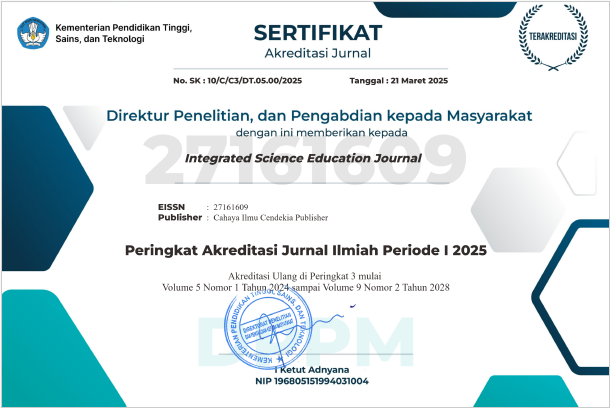The Effect of Integrating Green Sustainable Science and Technology into STEM Learning on Students’ Environmental Literacy
Abstract
Purpose of the study: This study aims to explore the integration of Green Sustainable Science and Technology (GSST) in STEM learning to improve junior high school students’ environmental literacy through a project-based learning approach.
Methodology: A qualitative case study design was employed. Data were collected through classroom observations, in-depth interviews with teachers and school officials, and document analysis. The data were analyzed using the Miles and Huberman model, which consists of data reduction, data display, and conclusion drawing.
Main Findings: The results show that teachers successfully integrated GSST into STEM learning through project-based activities, such as designing energy-saving devices using recycled materials. Students demonstrated high enthusiasm, gained meaningful learning experiences, and developed awareness of environmental protection. Supportive school policies and facilities further enhanced students’ conceptual understanding, environmental literacy, and positive attitudes toward sustainability.
Novelty/Originality of this study: This study introduces GSST integration into STEM learning at the secondary school level as an innovative model to enhance environmental literacy. The novelty lies in linking sustainability with practical project-based approaches, advancing educational practices that foster both conceptual mastery and environmental responsibility to support sustainable education.
References
M. Arntzen, E. Scheie, and B. Haug, “Unveiling perceptions: How science teachers perceive sustainable development and their expectations of students’ learning outcomes through environmental and sustainability education,” Int. J. Sci. Educ., vol. 0693, pp. 1–20, 2025, doi: 10.1080/09500693.2025.2499215.
E. Scharifi, A. Danilenko, U. Weidig, and K. Steinhoff, “Influence of plastic deformation gradients at room temperature on precipitation kinetics and mechanical properties of high- strength aluminum alloys,” J. Eng. Res. Appl., vol. 9, no. 1, pp. 24–29, 2019, doi: 10.9790/9622.
X. Zhang, X. E. Zhang, and L. Yang, “Does green entrepreneurial orientation improve the sustainable performance of agribusiness? evidence from China,” SAGE Open, vol. 14, no. 3, pp. 1–19, 2024, doi: 10.1177/21582440241271110.
A. Gharamohammadi et al., “Smart furniture using radar technology for cardiac health monitoring,” Sci. Rep., vol. 15, no. 1, p. 1392, 2025, doi: 10.1038/s41598-024-80062-5.
S. Jain, P. K. Jain, and A. K. Puranik, “Digital health technology & cancer care: Conceptual framework leading comprehensive fruitfulness,” J. Healthc. Leadersh., vol. 16, pp. 525–535, 2024, doi: 10.2147/JHL.S486263.
F. ul Haq, N. M. Suki, M. Setini, A. Masood, and T. A. Khan, “Adopting green AI for SME sustainability: Mediating role of green investment and moderation by green servant leadership,” Sustain. Futur., vol. 10, no. December 2024, p. 101002, 2025, doi: 10.1016/j.sftr.2025.101002.
M. Ghasemi, M. Govahi, and H. R. Litkohi, “Past and present of energy: The role of green finance, technological innovation, and financial risk in sustainibility indicators,” Int. J. Biol. Macromol., p. 138619, 2024, doi: 10.1016/j.indic.2025.100936.
C. C. Graham, “From ideologies to practice: A political ecology approach to green transitions–The case of Tanzania’s Ujamaa sustainability communities,” World Dev. Sustain., vol. 6, no. August 2024, p. 100217, 2025, doi: 10.1016/j.wds.2025.100217.
C. Zatti et al., “Turning alterations detected by mobile health technology in idiopathic REM sleep behavior disorder,” npj Park. Dis., vol. 10, no. 1, pp. 1–5, 2024, doi: 10.1038/s41531-024-00682-6.
A. Lauer, C. de Castro, and Ó. Carpintero, “Beyond Green capitalism: Global scenarios for fast societal transitions toward sustainability,” Environ. Innov. Soc. Transitions, vol. 56, 2025, doi: 10.1016/j.eist.2025.100981.
K. Zhao, D. Mendes, R. Butfield, and T. Mugwagwa, “Estimating hospitalization costs for Health Technology Appraisals (HTA) in England: a systematic literature review and best practice framework,” J. Med. Econ., vol. 27, no. 1, pp. 1558–1568, 2024, doi: 10.1080/13696998.2024.2430127.
D. Mizrahi et al., “Digital health technology use among people aged 55 years and over: Findings from the 45 and up study,” Int. J. Med. Inform., vol. 200, no. November 2024, p. 105911, 2025, doi: 10.1016/j.ijmedinf.2025.105911.
S. S. Shah, “Teaching and learning with technology: effectiveness of ict integration in schools,” Indones. J. Educ. Res. Technol., vol. 2, no. 2, pp. 133–140, 2022, doi: 10.17509/ijert.v2i2.43554.
E. Schwartz, T. Shamir-Inbal, and I. Blau, “Teacher prototypes in technology-enhanced instruction in elementary school second language acquisition: Comparing routine and emergency learning in different cultures,” Comput. Educ. Open, vol. 5, no. November, p. 100155, 2023, doi: 10.1016/j.caeo.2023.100155.
A. Koduah et al., “Institutionalizing health technology assessment in Ghana: Enablers, constraints, and lessons,” Heal. Syst. Reform, vol. 9, no. 3, 2023, doi: 10.1080/23288604.2024.2314519.
W. Guo et al., “Health technology assessment in China’s health care sector: Development and applications,” Heal. Syst. Reform, vol. 9, no. 3, 2023, doi: 10.1080/23288604.2024.2327099.
A. M. Herzallah et al., “Sustainable innovation as a catalyst: linking green supply chain practices to corporate reputation in emerging markets,” Clean. Logist. Supply Chain, vol. 16, no. December 2024, p. 100245, 2025, doi: 10.1016/j.clscn.2025.100245.
M. Ikram and J. E. Sadki, “Resilient and sustainable green technology strategies: A study of Morocco’s path toward sustainable development,” Sustain. Futur., vol. 8, no. September, p. 100327, 2024, doi: 10.1016/j.sftr.2024.100327.
S. Botwright et al., “Good practices for health technology assessment guideline development: A report of the health technology assessment international, HTAsiaLink, and ISPOR special task force,” Value Heal., vol. 28, no. 1, pp. 1–15, 2025, doi: 10.1016/j.jval.2024.09.001.
C. Perrotta, C. Bailey, and C. Garside, “Culture, technology and local networks: towards a sociology of ‘making’ in education,” Cambridge J. Educ., vol. 48, no. 5, pp. 553–569, 2018, doi: 10.1080/0305764X.2017.1375459.
M. J. Alam et al., “Agricultural extension service, technology adoption, and production risk nexus: Evidence from Bangladesh,” Heliyon, vol. 10, no. 14, p. e34226, 2024, doi: 10.1016/j.heliyon.2024.e34226.
S. Kusairi, S. Muhamad, N. A. Razak, and A. P. Trapsila, “The role of local wisdom ``Ugahari’’ and the impact of internet and mobile technology on work-life-balance during COVID-19 outbreak: Data set from malaysian workers,” Data Br., vol. 40, p. 107779, 2022, doi: 10.1016/j.dib.2021.107779.
T. Xia and X. Chen, “Unlocking sustainable production pathways: digital transformation driving green dual innovation in Chinese enterprises,” Clean. Environ. Syst., vol. 19, no. April, p. 100301, 2025, doi: 10.1016/j.cesys.2025.100301.
S. Y. Zheng, J. N. Han, F. Gandolfi, F. Alturise, and S. Alkhalaf, “Fostering eco-conscious tourists: How sustainable marketing drives green consumption behaviors,” Acta Psychol. (Amst)., vol. 255, no. March, p. 104900, 2025, doi: 10.1016/j.actpsy.2025.104900.
A. J. Turner et al., “Transporting Comparative Effectiveness Evidence Between Countries: Considerations for Health Technology Assessments,” Pharmacoeconomics, vol. 42, no. 2, pp. 165–176, 2024, doi: 10.1007/s40273-023-01323-1.
L. Kulembekova et al., “Stakeholders’ Involvement in Health Technology Assessment in Kazakhstan, Poland and Bulgaria,” Patient Prefer. Adherence , vol. 18, pp. 1009–1015, 2024, doi: 10.2147/PPA.S455838.
A. K. Ambusaidi and H. M. Al Dayri, “Investigating the current state of implementing sustainable green marketing among higher education students,” Cogent Bus. Manag., vol. 11, no. 1, p., 2024, doi: 10.1080/23311975.2024.2421410.
W. Khaokhajorn and N. Srisawasdi, “Assessing pre-service science teachers’ understanding of the nature of scientific inquiry to develop a sustainable technology-infused pedagogical program in teacher education,” Cogent Educ., vol. 11, no. 1, p., 2024, doi: 10.1080/2331186X.2024.2439160.
H. J. Evans and M. Achiam, “Sustainability in out-of-school science education: identifying the unique potentials,” Environ. Educ. Res., vol. 27, no. 8, pp. 1192–1213, 2021, doi: 10.1080/13504622.2021.1893662.
E. C. Ndlovu and M. T. Gumbo, “Decolonising Technology Education: Integrating Indigenous Knowledge for Sustainable Development in Electrical and Mechanical Systems and Control,” African J. Res. Math. Sci. Technol. Educ., vol. 28, no. 3, pp. 362–372, 2024, doi: 10.1080/18117295.2024.2381984.
P. Blose and M. T. Gumbo, “Developing a framework for integrating IKS in technology education with sustainable development principles,” African J. Res. Math. Sci. Technol. Educ., vol. 28, no. 3, pp. 330–342, 2024, doi: 10.1080/18117295.2024.2356416.
R. Kouser, G. Mahmood, W. A. Watto, M. Fahlevi, and A. L. Aziz, “Assessing the impact of green manufacturing and green technology innovation on sustainable green practices: unveiling the mediating role of eco-design,” Int. J. Sustain. Eng., vol. 18, no. 1, 2025, doi: 10.1080/19397038.2025.2538868.
L. Levin and D. De Filippo, “Evolution of the public understanding of science based on a bibliometric analysis of two major journals,” Tapuya Lat. Am. Sci. Technol. Soc., vol. 4, no. 1, 2021, doi: 10.1080/25729861.2021.1954381.
P. Duifhuis, G. van Dijk, and E. Savelsbergh, “Pre-service science teachers’ visions on education for sustainable development–tensions, underlying beliefs, and experiences,” Int. J. Sci. Educ., vol. 0693, pp. 1–22, 2025, doi: 10.1080/09500693.2025.2546459.
A. P. Vilbar, “Children as courseware collaborators: Using participatory research to produce courseware integrating science and sustainable development,” Cult. Sci., vol. 4, no. 1, pp. 25–39, 2021, doi: 10.1177/20966083211017351.
R. Mo, X. H. Peng, S. B. Wang, and J. Z. Zhang, “Knowledge mapping of green economy research: A bibliometric analysis,” SAGE Open, vol. 14, no. 4, pp. 1–16, 2024, doi: 10.1177/21582440241293581.
H. Chen, X. Cui, and Z. Li, “Research on the Impact of Digital-Realistic Integration to Promote Sustainable Development of Enterprises: Based on the Perspective of Technology Bias,” SAGE Open, vol. 15, no. 2, pp. 1–20, 2025, doi: 10.1177/21582440251329725.
S. Zhai et al., “Evaluating behavioral intervention technologies: Integrating human-centered design and implementation science outcomes,” Digit. Heal., vol. 11, 2025, doi: 10.1177/20552076251348579.
J. M. Luo, K. Y. Chau, Y. Fan, and H. Chen, “Barriers to the Implementation of Green Practices in the Integrated Resort Sector,” SAGE Open, vol. 11, no. 3, 2021, doi: 10.1177/21582440211030277.
F. Odoi-yorke, G. Mensah, D. D. Opoku, K. A. Ntiamoah, L. K. Osei, and C. K. K. Sekyere, “Empowering Ghana ’ s green hydrogen future : Innovative strategies to overcome barriers and drive sustainable energy transition,” Sage Journal, J. Res. Nurs., 2025, doi: 10.1177/27533735251378539.
I. T. P. Miranda, J. Moletta, B. Pedroso, L. A. Pilatti, and C. T. Picinin, “A Review on Green Technology Practices at BRICS Countries: Brazil, Russia, India, China, and South Africa,” SAGE Open, vol. 11, no. 2, 2021, doi: 10.1177/21582440211013780.
A. Baquero, “Examining the role of ambidextrous green innovation and green competitive advantage in stimulating sustainable performance: The moderating role of green absorptive capacity,” SAGE Open, vol. 14, no. 4, pp. 1–22, 2024, doi: 10.1177/21582440241294160.
Y. Li, T. R. Pertheban, Q. Li, and Z. Guang-Wen, “The Green Innovation Gateway: How Technological Capabilities and Environmental Strategies Drive Sustainability Performance in Manufacturing Firms,” SAGE Open, vol. 15, no. 3, pp. 1–21, 2025, doi: 10.1177/21582440251360842.
Copyright (c) 2025 Nguyen Nhu Le, May Zin Aye

This work is licensed under a Creative Commons Attribution 4.0 International License.
Authors who publish with this journal agree to the following terms:
- Authors retain copyright and acknowledge that the Integrated Science Education Journal is the first publisher licensed under a Creative Commons Attribution 4.0 International License.
- Authors are able to enter into separate, additional contractual arrangements for the non-exclusive distribution of the journal's published version of the work (e.g., post it to an institutional repository or publish it in a book), with an acknowledgment of its initial publication in this journal.
- Authors are permitted and encouraged to post their work online (e.g., in institutional repositories or on their website) prior to and during the submission process, as it can lead to productive exchanges and earlier and greater citation of published work.







.png)
.png)






